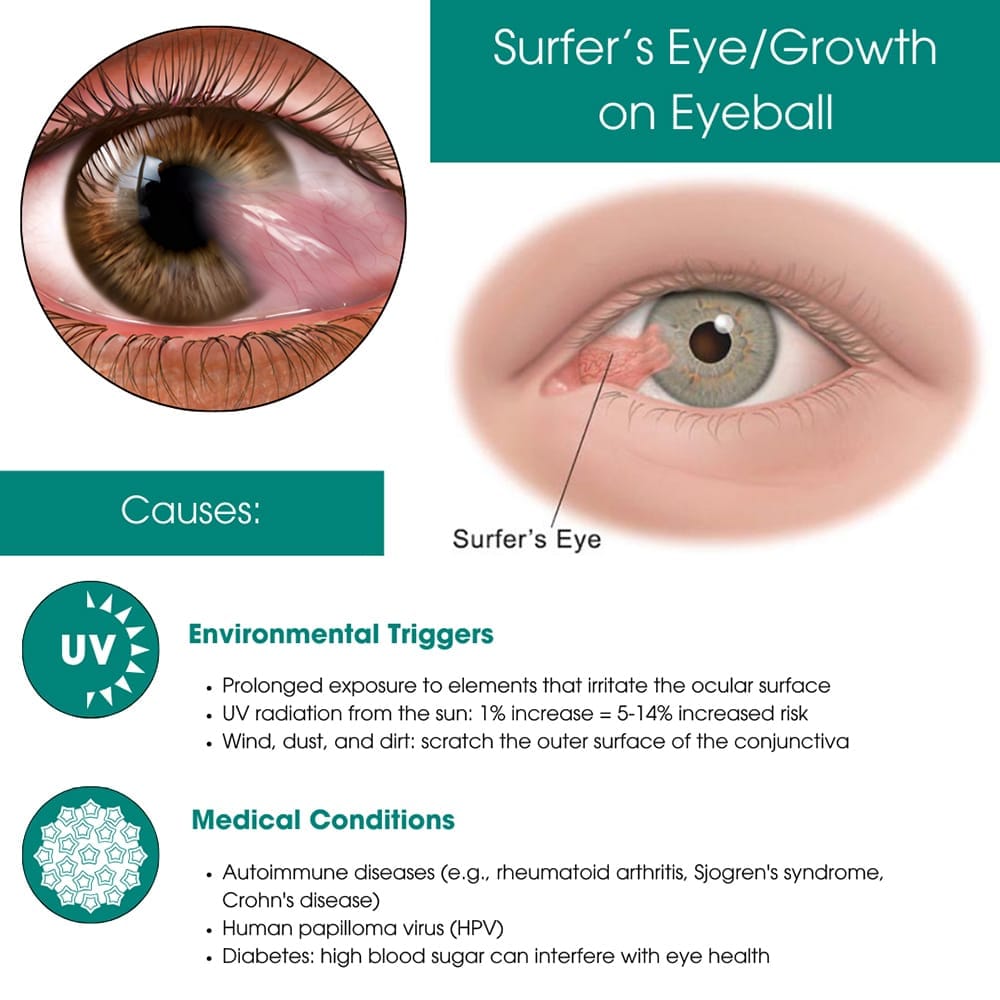Surfer’s eye, medically called pterygium, is an eye condition characterized by a raised, fleshy growth on the conjunctiva, the white part of the eye. The growth typically appears on the side closest to the nose and could extend onto the cornea of the eye. While there is no exact cause for the condition, researchers believe that prolonged exposure to ultra-violet rays causes problems in the biological makeup of the eye. It’s estimated that 10 to 15 million Americans potentially need surfer’s eye treatment.
Growth on eyeball or eyelid is a common occurrence that’s easily manageable when you routinely get eye tests. Usually, comprehensive eye care administered by your NYC optometrist catches difficult eye problems like growths that may need pterygium surgery. For locals in Downtown Manhattan, Eye Physicians has the best and most thorough adult and pediatric eye doctors around.

The source of surfer’s eye is multifaceted, with the primary environmental trigger being prolonged exposure to the elements that irritate the ocular surface. While UV radiation from the sun is a known risk factor, a deep dive reveals startling results. Even a one percent increase in ultraviolet radiation increases the risk of developing surfer’s eye by five to 14 percent.
Besides the sun damaging the delicate eye cells, you have the wind playing an active role. Dust and dirt cause problems by scratching the outer surface of the conjunctiva. For those who work primarily outdoors, you’re twice as likely to develop the condition.
Medical conditions also influence the development of surfer’s eye. Consult your NYC optometrist to rule out serious underlying eye problems if you suffer from conditions such as:
According to the World Health Organization, ground surfaces like water reflect sunlight at 25 percent, beach sand at 15 percent, with snow being the most dangerous, reflecting nearly 80 percent of harmful UV radiation. This means anyone who loves water sports, like surfers, or winter sports, like skiers, is at risk. Additionally, if you live in a sunny, arid climate and spend more than four hours a day in the sun without protection, you’re risking getting sunburned eyes and surfer’s eye.
Those from countries near the equator where the sun is always glaring, are ten times more likely to suffer from pterygium. In the US, African Americans are two to three times more at risk than Caucasians. Higher incidences of the condition are also seen more in rural areas as people spend more time outdoors. Besides the location, other factors that make you vulnerable include:
The first thing you notice is the pink on the white conjunctiva that you could mistake for pink eye or blepharitis. Eyelids Yet the wing-shaped pink area is slightly raised, a clear sign for surfer’s eye. Most cases of surfer’s eye are non-cancerous and with early detection, the symptoms are easily controlled.
If left untreated, however, you could end up with a growth that’s unsightly, covers the cornea and needs emergency eye care. You may also notice other signs that you or your kids need surfer’s eye treatment, such as:
Additionally, the growth on the cornea could cause blurry vision and headaches that could make activities requiring sharp vision challenging like reading and driving. Your New York City based optometrist may suggest a refraction eye exam to confirm astigmatism. Once diagnosed, astigmatism correction is needed to resolve the refractive error before you receive surfer’s eye treatment.
Based on the slit-lamp examination, your optometrist may recommend treatments that reduce the swelling and redness.
For mild cases, your doctor may recommend the following treatments:
For patients with advanced pterygium affecting vision, surgery is the only definitive treatment. However, it requires ongoing monitoring and there’s a chance of recurrence. Several surgical techniques are available:
Mitomycin C can be used during surgery to help prevent pterygium regrowth. Both grafting techniques aim to restore the eye’s surface and reduce the risk of complications.
Given there is a 30 to 40 percent chance of recurrence, you also need to take precautionary measures to prevent the condition from happening again, such as:
It’s also worth checking your eye health regularly and maintaining a healthy lifestyle.
Contact your New York City surfer’s eye specialist for an appointment at the first sign of growth on eyeball or any other irregular eye occurrence. Don’t take chances with your vision.
Eye Physicians
110 Lafayette St, Suite 503
New York, NY 10013
(212) 292-4814
Entrust the care of your precious eyesight to highly skilled and experienced eye care professionals. For top-notch ophthalmologists and optometrists in Downtown Manhattan, choose Eye Physicians. Eye Physicians ensures prompt care, precise diagnosis, and personalized treatment plans.
Schedule an Appointment